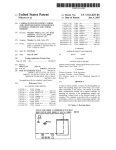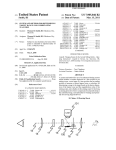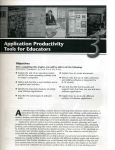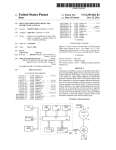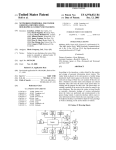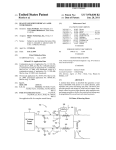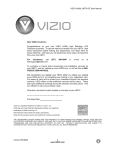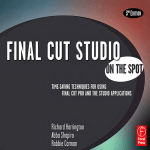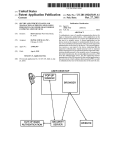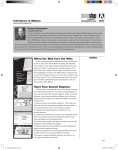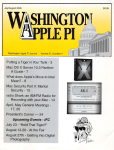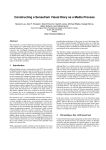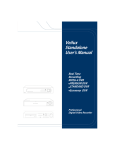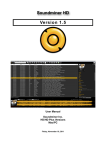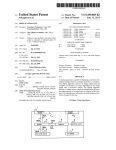Download Multiple-camera video recording
Transcript
USOO7823056B1 (12) United States Patent (10) Patent N0.2 Davey et a1. (54) (75) US 7,823,056 B1 (45) Date of Patent: MULTIPLE-CAMERA VIDEO RECORDING 6,324,335 B1 Inventors: Matthew Davey, Grown, MA (Us); David KHSPa, San Jose, CA (Us); Oct. 26, 2010 11/2001 Kanda 6,351,765 B1 2/2002 Pietropaolo et al. 6,353,461 B1 * 6,452,612 B1 * 3/2002 Shore et a1. ............... .. 348/722 9/2002 HOltZ et a1. ............... .. 715/723 Steven Warner, Sunnyvale, CA (Us); 6,459,711 B1 Michael Gregory Jennings, San Jose, 6,621,503 B1 * 10/2002 Hamaguchi et a1. CA (Us) 6,670,966 B1 9/2003 Ubillos ..................... .. 715/723 12/2003 Kusanagi (73) Assignee: Adobe Systems Incorporated, San Jose, CA (U S) ( * ) Notice: Subject to any disclaimer, the term of this (commued) patent is extended or adjusted under 35 OTHER PUBLICATIONS U.S.C. 154(b) by 1210 days. Monohan, Avid Xpress Pro for Windows and Macintosh: Visual (21) Appl. No.: 11/429,134 (22) Filed: QuickPro Guide, Published Nov. 18, 2003, Peachpit Press, pp. 206 208* May 4, 2006 _ (Continued) Related U.S. Appllcatlon Data (63) Continuation-in-part of application No. 11/377,885, Primary ExamineriDoug Hutton ASSiSllml ExamineriFrank D Mills ?led on Mar, 15, 2006~ (51) Int, Cl, G06F 3/00 (74) Attorney, Agent, or FirmiFish & Richardson PC. (57) ABSTRACT (2006.01) (52) US. Cl. ..................................... .. 715/202; 715/723 (58) Field of Classi?cation Search ............... .. 715/216, 71 5 /723 Techniques and Systems for recordng video and audio in timeline sequences. In some embodiments, a method involves See application ?le for complete search history playing video from a timeline sequence that can include foot age from portions of video tracks including at least one pre recorded edit. In response to a selection of footage from the (56) References Cited timeline sequence, the method can involve overwriting at least one pre-recorded edit in the timeline sequence. Each US. PATENT DOCUMENTS 5,187,571 A * 5,206,929 A * 2/1993 Braun et al. ................ .. 348/39 4/ 1993 LflnngTd et 31~ ~~~~~~~~~~ -- 715/723 video track can correspond to a respective camera in a mu] tiple-camera source. The footage can include one or more 5,442,744 A 8/1995 PleChet 31~ video clips, still images, frames, and moving images. The 5,598,208 A * 5,613,032 A * 1/ 1997 McCl1ntock .............. .. 348/ 159 3/1997 Cruz et al' ~~~~~~~~~~~~~~~~~~ ~~ 386/69 overwriting can occur While playing the Video at a play rate faster than realtime, a play rate slower than realtime, a user 5’732’184 A * 3/1998 Chao et 31' selected playing rate, during video scrubbing, or during real A Lavallee et 31. . . . . . . . . .. playback' The recording may involve ajump back input, 5,760,767 A * 6/1998 Shore et al. ............... .. 715/723 and 5,781,188 A 7/1998 Amiot et a1. timelpine se Hence p 6,243,085 B1 * 6/2001 6,253,461 B1 7/2001 Fischer 6,317,166 B1 * unch in and Roach ...................... .. 715/202 q 11/2001 McCutchen ............... .. 348/722 Camera 1 Window 120 ' 22 Claims, 10 Drawing Sheets Camera 2 Window Selected Camera Window 1% Camera 3 Window Camera 4 Window ? liq Timeline Panel 1_3_s Multiple-Camera Control Panel m 110/ Multiple-Camera Monitor unch out locations associated With the US 7,823,056 B1 Page 2 Peter Wiggins Reviews Multicam Lite, Creativecow.net Product U.S. PATENT DOCUMENTS 6,675,386 6,699,127 6,763,177 7,024,677 7,037,127 B1 B1* B1* B1* B2 7,055,100 7,073,127 7,124,366 7,196,722 7,199,817 7,325,199 B2 B2 B2 B2 B2 B1 Review; United Kingdom; Internet: http://www.creativecow.net/ar ticles/wigginsipeter/multicamirev/; (1 of 16) Nov. 24, 2005 1/ 2004 Hendricks et al. 3/2004 Lobb et al. .................. .. 463/43 11:10:43 AM. 7/2004 Abe et al. Working With Multiclips, Chapter 16, pp. 247-288. “Group Clip Editing,” Chapter 18 in TheAvid User Manual, 11 pages 4/2006 5/2006 5/2006 7/2006 10/2006 3/2007 4/2007 1/2008 .... .. .. Snyder et al. ............... .. 725/86 Williams Moriwake et al. Zhao et al. Foreman et al. White et al. Mottur etal. Reid 7,356,242 B2 4/2008 Nagasawa 7,428,002 B2 9/2008 Monroe 2001/0036356 A1* 11/2001 2001/0040592 A1 11/2001 Foreman etal. 2002/0133827 A1* 2002/0196329 A1* 12/2002 (accessed on Mar. 8, 2006). “Hot Shots with Premiere Pro 2.0: Multicam Editing, Tutorial Series Part 2,” http://ads.digitalmedianet.com/ads/servelet/clicld zone?Zid:117&pid:0&lookup:true&position-1 6 pages, (accessed Feb. 22, 2006). “Multicam Features,” http://www.unitedmediainc.com/multicam, 2 pages, (accessed on Jan. 10, 2006). White, Charlie, “Hot Shots with Premiere Pro 2.0: Multicam Editing, Weaver et al. ............... .. 386/52 9/2002 Newnam et al. ............ .. 725/89 Dudkowski ................ .. 348/48 2003/0002851 A1 1/2003 Hsiao et al. 2003/0039471 A1* 2003/0077071 A1* 2/2003 4/2003 Hashimoto ................ .. 386/111 Lin et al. ....... .. 386/68 2003/0197785 A1* 10/2003 White et al. .......... .. 348/207.99 386/52 Part 4/2004 Silverstein et a1. 4/2004 Yuen 2/2005 Belhumeur et a1. pages. 2005/0094966 A1* 2005/0206720 A1* 5/2005 9/2005 pages. 12/2005 Cutler 8/2006 Rohl?ng et al. Arora et al. ................. .. 386/46 2006/0279628 A1* 12/2006 2006/0288288 A1* 12/2006 Girgensohn et al. 5/2007 67 Dunn, USPTO Of?ce Action in US. Appl. No. 11/506,389, mailed Mar. 9, 2009, to be published by USPTO as part of the ?le history, 10 Elberbaum ................. .. 386/46 Cheatle et al. ......... .. 348/14.08 5/2006 pages, com/pro ducts/Newscutter%20Adrenaline%200verview. htrnl, 2004/0066457 A1 2004/0080624 A1 2005/0034076 A1 2006/0104601 A1* 2 pages, (accessed on Apr. 4, 2006). Dunn, USPTO Of?ce Action in US. Appl. No. 11/506,389, mailed Jun. 26, 2008, to be published by USPTO as part ofthe ?le history, 8 3/2004 3/2004 2006/0171453 A1 http://ads.digitalmedianet.com/ads/servlet/clicld (accessed on Apr. 4, 2006). “Avid NewsCutter Adrenaline FX,” http://www.virtualmediaonline. 2004/0042103 A1* 2004/0047208 A1* Mayer ...... .. 360/7 Hoddie et a1. ............. .. 365/202 2,” zone?Zid:1 17&pid:0&lookupItrue&position:1, 11/2003 2007/0113182 A1* .. “Hot Shots with Premiere Pro 2.0: Multicam Editing, Tutorial Series 2003/0215214 A1* 2005/0285943 A1 Ma Tutorial Series, Part 2,” http://www.digitalvideoediting.com/articles/ viewarticle.jsp?id-:36989, 9 pages, (accessed on Feb. 22, 2006). Fleming ................... .. 348/143 . 715/716 Hollemans ................ .. 715/723 Media 100iAdvanced Editing Systems, available at: http://www. mwdia100.com/products/php, printed on Jul. 9, 2009. Stitt, USPTO Of?ceAction in US. Appl. No. 11/377,885, mailed Jul. 9, 2008, to be published by USPTO as part of the ?le history, 16 pages. Stitt, USPTO Of?ce Action in US. Appl. No. 11/377,885, mailed Jan. 14, 2009, to be published by USPTO as part ofthe ?le history, 17 2007/0183768 A1 8/2007 Mottur et al. pages. 2007/0201815 A1* 8/2007 Grif?n ....................... .. 386/52 2008/0019576 A1 1/2008 Senftner et al. Stitt, USPTO Of?ce Action in US. Appl. No. 11/377,885, mailed Apr. 29, 2009, to be published by USPTO as part of the ?le history, 16 2008/0044155 A1* 2/2008 pages. Kuspa ....................... .. 386/52 OTHER PUBLICATIONS Monohan, Avid Xpress Pro for Windows and Macintosh: Visual Tran, International Search Report, Application Serial No. PCT/ US07/76155, dated Sep. 22, 2008, 8 pages. Stitt, USPTO Of?ce Action in US. Appl. No. 11/377,885, mailed Nov. 9, 2009, to be published by USPTO as part of the ?le history, 20 Quickpro Guide, p. 119-122 (Peachpit Press, Nov. 18, 2003).* Group Clip Editing, Chapter 18, 11 pages. pages. Hot Shots with Premiere Pro 2.0: Multicam Editing, Tutorial Series, Part 2; 2 pages. * cited by examiner US. Patent Oct. 26, 2010 Sheet 3 0f 10 US 7,823,056 B1 co\\m Q6EchF 326 own 65:. mm owxmEt>. § omxmEc>. § 8N?2g>,Q 3x58>; 0Nm5e2E4. ,? 9m*253; Q 0wxo:m3t. mm US. Patent 0a. 26, 2010 Sheet 5 0f 10 US 7,823,056 B1 Create or Edit Tracks by Assembling Clips and Footage on One or More Tracks Arrange and/0r Synchronize the Tracks to Generate or Edit the Source Tirneline Sequence 516\ v Place the Source Tirneline Sequence into a Track of the Target Timeline Sequence Arrange and/or Synchronize the Tracks to Generate or Edit the Target Timeline Sequence FIG. 5 US. Patent 0a. 26, 2010 Sheet 6 6f 10 US 7,823,056 B1 Step Forward Step 5%“ Play 614 6‘8 Next Edit 616 622 lliilllilifll l||!i lilillllllll r>Ti> Play Around t 634 636 612 JO Previous E dit 9 Shuttle 670 638 Record FIG. 6A 6105 N Step Back Play/Stop (Left) Toggle (Space) 614 616 K llilllillili Step Forward (Righi) 618 / Flllillillfliiillllil Te \<||1\r> Play Around , rd => ‘ I 1 612 634 636 Go to Previous Edit Point (Page Up) J09 Shuttle rm 9 JB l K 533 Record 622 Go to Next Edit Point (Page Down) FIG. BB space US. Patent 0a. 26, 2010 Sheet 7 0f 10 US 7,823,056 B1 Play Video from a Timeiine Sequence that has At Least One Prerecorded Edit Do not Overwrite the At Least One Pre-recorded Edit Overwrite At Least the One Pre-recorded Edit FIG. 7 US. Patent Oct. 26, 2010 US 7,823,056 B1 Sheet 8 0f 10 HEW“ [E] l l [[11 \ US; a m... 58538. E 05: 858%w.E5+ ocmwtoa /séz_.mmoo§sz_O.nm| com1/ 2%ma83;% _ u" m .OEw \AlEv :Us:I;mEozmnomw >BE392N DE8m%; ./l 1/ me ,flm w \ m:Us;E5uzm omw MEQKF Cd gmDE@632 anDE@532 US 7,823,056 B1 1 2 MULTIPLE-CAMERA VIDEO RECORDING faster than realtime, a play rate slower than realtime, a user CROSS-REFERENCE TO RELATED APPLICATIONS associated with the multiple-camera source can include a selection of an overwrite selector to enable or disable over selected play rate, or during video scrubbing. The selection writing. This application is a continuation-in-part application of, and claims priority to, US. patent application Ser. No. l l/377,885, entitled “MULTIPLE-CAMERA VIDEO EDIT ING TECHNIQUE,” to inventors MATTHEW DAVEY, DAVID KUSPA, AND STEVEN WARNER, which was ?led on Mar. 15, 2006. The disclosure of the above application is 10 incorporated herein by reference in its entirety. The operations can also include presenting a preview mode in a graphical user interface for displaying the timeline sequence when the overwrite selector disables overwriting. The overwriting can involve overwriting at least one pre recorded edit in the timeline sequence in response to the playing video reaching a punch-in location on the timeline sequence. The overwriting can also involve stopping the over writing in response to the playing video reaching a punch-out BACKGROUND location on the timeline sequence. The operations can include displaying a preview mode in a graphical user interface for the The present disclosure relates to video recording tech niques using video sources from multiple cameras. Multiple camera video recording involves the synchronizing and edit playing video corresponding to the punch-in and punch-out ing of video of an event recorded from multiple cameras simultaneously. The multiple cameras are typically at differ locations. The playing can involve playing video from a target time line sequence that includes video footage and a target video 20 track, in which the target video track can include a source ent locations and can record the event from a different per video timeline sequence with the video tracks corresponding spective, angle, or with a different audio source. A multiple camera setup can be used to shoot most studio-produced television programs such as situation comedies, soap operas, news programs, game shows, talk shows, or events, such as to respective cameras in a multiple-camera source. The foot age can include one or more video clips. The selection asso 25 ceremonies, athletic games, community events and musical performances. In recording a wedding event, for example, a ?rst camera may be recording the event from the perspective of a bride and groom, a second camera may be recording the event from a perspective of a musician, a third camera may be 30 recording the event from a perspective of a wedding admin istrator, and a fourth camera may be recording the event from a perspective of a wider, master shot to capture the overall action and establish the geography of the room. Traditionally, each camera had the recording on a tape, the recorded footage 35 multiple-camera source. The operations can also include, in response to a selection of a jump back input, rewinding the playing video a pre-de?ned amount of time or frames. The rewinding the playing video can provide an option or oppor tunity to re-overwrite at least one pre-recorded edit in the timeline sequence. The rewinding can involve positioning the playing the video at a locationbefore at least one pre-recorded edit in the timeline sequence. The playing of the video can resume immediately after the rewinding at the rewound loca tion in the timeline sequence. In another general aspect, the techniques feature a system from the tapes were synchronized, and then edited on a master recording. Today, the recording and editing is often per formed digitally, and the source footage from a clip from each camera can be selected and combined into a single, ?xed video clip and saved on a computer storage medium. ciated with the multiple-camera source can include a selec tion of footage from at least one of the cameras in the 40 SUMMARY or software product that includes a graphical user interface con?gured to present a ?rst video track, a ?rst timeline sequence, and a second timeline sequence. The ?rst video track includes a ?rst footage. The ?rst timeline sequence includes at least some portions from a ?rst set of video tracks, in which the ?rst set of video tracks includes at least some portions of the ?rst footage and footage from multiple video In general, in some aspects, the disclosure features tech tracks other than the ?rst footage. The second timeline niques and products for recording in timeline sequences for sequence includes at least some portions from a second set of multiple-camera video sources. Some aspects feature a com video tracks, in which the second set of video tracks includes at least some portions of the ?rst timeline sequence. The system or software product also includes multiple monitors in the graphical user interface con?gured to concurrently dis puter program product, encoded on a computer-readable medium, operable to cause data processing apparatus to per form operations including playing video from a timeline sequence, in which the timeline sequence includes footage from portions of video tracks, and each video track corre 50 sponds to a respective camera in a multiple-camera source. The timeline sequence includes at least one pre-recorded edit. The operations also include, in response to a selection asso ciated with the multiple-camera source, overwriting at least one pre-recorded edit in the timeline sequence, in which the overwriting occurs while the video from the timeline sequence is playing. Advantageous embodiments of the disclosure include one 55 or more of the following features. The operations can involve 60 concurrently presenting video from the timeline sequence and each of the video tracks in a distinct monitor from mul tiple monitors. The selection associated with the multiple corresponding to a video track to overwrite the at least one can occur while playing the video in realtime, at a play rate sequences.At least one video track in at least the ?rst timeline sequence corresponds to a distinct monitor from the multiple monitors, and at least one video track in at least the ?rst set of video tracks corresponds with footage from a distinct camera in a multiple-camera video source. The system or software product also includes a monitor selector con?gured to select a monitor playing video associated with a video track in a group that includes the ?rst video track, the ?rst set of video tracks, or the second set of video tracks to overwrite pre recorded edits from at least some portions of any of the timeline sequences playing in at least one of the multiple monitors. Advantageous implementations can include one or more of the following features. At least one monitor can be con?gured camera source can include a selection of at least one monitor pre-recorded edit in the timeline sequence. The overwriting play footage for any of the video tracks and timeline 65 to display a preview of potential overwrites of the pre-re corded edits. The system or software product can be further con?gured to display video in a preview mode in at least one US 7,823,056 B1 3 4 monitor in the graphical user interface for punch-in and one or more of the clips. Each video clip can have a corre punch-out locations in at least one of the timeline sequences. The punch-in locations can represent locations where the sponding audio track. sponding audio clip, and each video track can have a corre system or software product is con?gured to overwrite the pre-recorded edits in the ?rst or second timeline sequence when the video playing reaches the punch-in location on the ?rst or second timeline sequence. The punch-out locations can represent locations where the system or software product provide advantages over traditional video tape recording in that the recording can be performed digitally, in software, and is con?gured to end the overwriting of the pre-recorded edits video clips can be arranged in a non-linear fashion from the in the ?rst or second timeline sequence when the video play ing reaches the punch-out location on the ?rst or second timeline sequence. The system or software product can include a recording selector to overwrite pre-recorded edits from at least some portions of any of the timeline sequences. source or destination. Users can be allowed to preview video footage that can be recorded onto the track or timeline The disclosure can include a control panel for a digital video system that can provide a familiar recording metaphor, such as a control for a video tape recorder. The disclosure can sequence. Video footage on a track or timeline sequence can be overwritten, so that existing edits can be overwritten with out requiring a manual adjustment of the video clips or a When the recording selector is enabled, the recording selector can be con?gured to create an edit location in at least one of removal of the pre-existing edits. A user can make edits on a track on a ?rst pass during playback, rewind to or past an edit the timeline sequences that is playing, in which the video in point on the track, and re-record on the track to overwrite the the at least one of the timeline sequences can be overwritten edit point with footage from another video source. The edit at the edit location with footage from a selected monitor. The system or software product can also include a jump back input to rewind the video playing a predetermined amount of time or frames to provide an option to re-overwrite the pre-re corded edits in at least one timeline sequence. The rewinding can involve positioning the playing video at a location before point can be located between two clips on a track. at least one pre-recorded edit in at least one timeline sequence. In another general aspect, the techniques feature a method of recording video that includes playing video from a timeline sequence, in which the timeline sequence includes footage from portions of video tracks, and the timeline sequence also 20 the timing of the switching between camera angles, or extend ing or shortening a length of the video clips in a track without requiring manual edit techniques, such as removing an edit 25 from the deletion of adjacent clips. At anytime during the playback of the video, the user can “punch in” to start over 30 tion of footage from the timeline sequence, the method writing and “punch out” to stop overwriting, and then play back the edits made during the punch-in, punch-out segment. The overwriting of the pre-recorded edit can occur while playing the video at a play rate that is faster than realtime, a play rate that is slower than realtime, a user-selected playing 35 Advantageous implementations can include one or more of the following features. The overwriting can include overwrit ing while playing the video at a play rate faster than realtime, a play rate slower than realtime, a user-selected playing rate, point, making a rolling edit adjustment to slide the edit point forward or backward in time, deleting unwanted camera angle clips, or extending clips to ?ll in gaps that were created includes at least one pre-recorded edit. In response to a selec includes overwriting at least one pre-recorded edit in the timeline sequence, in which the overwriting occurs while the video in the timeline sequence is playing. Other advantages of the disclosure can offer overwriting the video on a track to use different camera angles, changing rate, during video scrubbing, or during realtime playback. The overwriting can occur in any number of video clips in a video track, and for any number of video tracks in a timeline during video scrubbing, or during realtime playback. In sequence. In some embodiments, the overwriting can occur in a ?rst timeline sequence that is nested within a track of a 40 second timeline sequence. In some embodiments, the over response to selecting a jump back input, the video playing can writing can occur for video associated with multiple-camera be rewound a pre-de?ned amount of time or frames. The rewinding of the video a pre-de?ned amount of time or frames sources, while in other embodiments overwriting can occur for video not associated with multiple-camera sources. can provide an option to re-overwrite the pre-recorded edits in the timeline sequence, in which the rewinding can involve positioning the playing video at a location before at least one The details of one or more embodiments of the disclosure 45 pre-recorded edit in the timeline sequence. The playing of the video can resume immediately after the rewinding at the rewound location in the timeline sequence. The selecting can include a selection of at least one monitor corresponding to a 50 video track to overwrite the pre-recorded edits in the timeline sequence. The method can also include displaying the playing BRIEF DESCRIPTION OF THE DRAWINGS FIG. 1 shows an example multiple-camera monitor. video in a preview mode in a graphical user interface that FIG. 2 shows an example source panel for a source timeline sequence. corresponds to punch-in and punch-out locations, overwrit ing at least one pre-recorded edit in the timeline sequence when the playing video reaches the punch-in location on the timeline sequence, and stopping the overwriting of at least one pre-recorded edit in the timeline sequence when the play ing video reaches the punch-out location on the timeline 55 sequence. Particular embodiments of the disclosure can be imple mented to realize one or more of the following advantages. There can be multiple tracks of video clips in a timeline sequence, in which each track includes video clips from a respective camera. In other words, the timeline sequence can 60 serve as a container for all or portions of one or more tracks, and each track can serve as a container for all or portions of are set forth in the accompanying drawings and the descrip tion below. Other features, aspects, and advantages of the disclosure will become apparent from the description, the drawings, and the claims. FIG. 3 shows an example target panel for a target timeline sequence. FIG. 4 shows an example of embedding the source timeline sequence into the target timeline sequence. FIG. 5 shows a ?owchart for generating a target timeline sequence. FIGS. 6A-6B show examples of control panels. FIG. 7 shows a ?owchart for overwriting pre-recorded edits. 65 FIG. 8 shows an example of a timeline sequence. FIG. 9 shows an example of punch-in and punch-out loca tions in a timeline sequence. US 7,823,056 B1 5 6 FIG. 10 shows an example of a jump back input in a graphical user interface. tiple-camera monitors can be used to facilitate editing. The Like reference numbers and designations in the various drawings indicate like elements. trol monitor selection and editing of any of the tracks and timeline sequences. DETAILED DESCRIPTION A system or software user can select one of the video tracks to be the selected track as part of the source timeline system or software program can include a controller to con sequence. As compared with traditional multiple-camera editing, the instant disclosure provides techniques by which In some embodiments, a user of a system or software program can assemble various clips into one or more tracks of multiple audio or video clips can be included in each track. In other words, there need not be a limit of having only one clip per track after combining clips from multiple camera source footage. A video/ audio track can be selected and inserted into, removed from, or referenced from the timeline sequence video and audio corresponding to the video. All or portions of any of the multiple tracks can be used to generate a ?rst (source) timeline sequence of video or audio. All or portions of the source timeline sequence can be inserted into at least one track of a second (target) timeline sequence. The insertion of the source timeline sequence into a track of the target timeline sequence canbe referred to as “embedding” or “nest without destroying or modifying the video/audio clips within the video/audio track. Since the clips and/or the tracks them selves need not be altered, deleted, or modi?ed, those clips and/or tracks can be retrieved later in their entirety for sub sequent editing into the timeline sequence. After the edits ing” the source timeline sequence into the target timeline sequence. The target timeline sequence can be generated from all or portions of any of the multiple, target tracks. In some embodiments, the embedding/nesting can refer to inserting and including the source timeline sequence into a target track of the target timeline sequence. In other embodi ments, the embedding/nesting can refer to pointing, mapping, linking, or referring to the source timeline sequence from the target track of the target timeline sequence. In other words, the target track of the target timeline sequence can point to or refer to the source timeline sequence instead of having the audio/video footage of the source timeline sequence inserted within the target track of the target timeline sequence. In some embodiments, the target timeline sequence can be 20 have been made to the source timeline sequence, the tracks, the clips, or any of their combinations, within the source timeline sequence, the target timeline sequence can be auto matically updated to include the changes of the source time 25 line sequence. The changes to the contents of the source or target timeline sequences can automatically be shown in a window or monitor. When video tracks are created by assem bling the video clips, the software program can automatically generate corresponding audio tracks if corresponding audio is available for the video clip. Also, when the source and target timeline sequences are created or edited, the software pro 30 gram can automatically generate and update source and target edited, allowing for insertion or removal of all or portions of audio timeline sequences to correspond to the source and the multiple-camera video and/or audio tracks, including the target video timeline sequences. source timeline sequence, and/or video and audio tracks and clips within the source timeline sequence, any references of or pointers to the timeline sequences or tracks, or any editing combination thereof. The software can provide a display of each of the multiple-camera tracks from the source timeline sequence, and allow those tracks and/or video clips within The target timeline sequence can include video and audio from multiple, embedded, source timeline sequences. All or portions of the source timeline sequences can be included in the target timeline sequence. Multiple video tracks can be synchronized at a point in the timeline or during an event. So those tracks to be added or deleted. When edits are made to the source timeline sequence, the 35 when synchronized, there can be multiple cameras displaying the same event in the multiple-camera monitor at the same 40 target timeline sequence can automatically be updated with the changes. The changes can be displayed in a multiple camera monitor. Each monitor can refer to a separate window or screen on a user’s display panel, each monitor can display time. The synchronization can be performed automatically by the software, manually by the user of the software, by a similar time length of the tracks, by a similar recording time of the video footage of the tracks, or by an audio or video one of the video tracks, and each video track can correspond to video footage from a distinct camera in the multiple-cam era system. Additional monitors can be used for displaying the source and target timeline sequences. For example, moni tors can be used to present audio/video in the assembly or 45 edits of multiple audio/video clips into the audio/video tracks 50 marker or cue. The audio can follow the video. Alternatively, the audio can be inserted into or deleted from any of the tracks and timeline sequences. Multiple-camera monitors can simultaneously display multiple camera angles playing in a source and/or target timeline sequence. As shown in FIG. 1, an example multiple-camera monitor of the source timeline sequence, and monitors can be used to 110 can display video footage from four different cameras. The multiple-camera monitor 110 can be shown in a panel or present audio/video in the generation or edits of the source window in a display, and can be used to create a timeline and target timeline sequences. sequence. Creating the timeline sequence can involve editing, such as inserting or removing, all or portions of video tracks from the timeline sequence at different time locations in the The system or software program can include a multiple camera monitor, in which each track can be shown in a sepa 55 rate monitor. Each track can include audio and video clips corresponding to footage from one of the cameras. The mul tiple-camera monitor can display monitors for simultaneous video tracks, and can include a monitor displaying a selected track that is designated to play from the source timeline sequence. In some embodiments, the multiple-camera moni tor can display a number of separate streams of video, in 60 timeline sequence. In this aspect, the timeline sequence can include various portions of video clips from one or more selected video tracks. Camera 1 Window 120 shows footage from a ?rst camera, Camera 2 Window 124 shows footage from a second camera, Camera 3 Window 128 shows footage from a third camera, and Camera 4 Window 130 shows footage from a fourth camera. Each of the camera windows shows footage from a distinct track of video from the source sequence. Each track which each stream of video can correspond to a track and can be shown in a separate monitor or portion of a monitor. There can be an output monitor or a preview monitor to present 65 of video can be created from one or more video clips. Video clips can refer to a segment of a video recording, video foot audio/video in the source timeline sequence or the target age with a ?nite duration, or a ?le that contains a short video timeline sequence. In other embodiments, any of the mul US 7,823,056 B1 7 8 item, such as an excerpt from a longer video recording. For example, video clips may be short ?lms, or even promotional videos, such as in commercials and advertisements. Each track of video may also include other types of still images, can be manually synchronized by a software user, or can be synchronized automatically with the software program. FIG. 2 shows an example source panel 200 for a source frames, and moving images, such as B-roll and stock footage. The multiple-camera monitor can facilitate the creation of a track of video by allowing a software program user to insert and delete video clips from a track, in which the track and corresponding changes to the track can be displayed in a window of the multiple-camera monitor 110. Also, each track of video may have a corresponding track of audio. The time line panel 138 can display a total duration of video footage, and present time locations for the video footage for one or more of the tracks. The timeline panel can also include time 10 timeline sequence. The source panel 200 may be displayed along with the multiple-camera monitor 110, and can be used in creating the source timeline sequence. The source panel 200 shown in FIG. 2 has four video tracks, Video 1 Track 218, Video 2 Track 212, Video 3 Track 206, andVideo 4 Track 202, and four audio tracks, Audio 1 Track 236, Audio 2 Track 232, Audio 3 Track 228, and Audio 4 Track 224. The source panel 200 is not limited to the number of audio and video tracks shown, but may include any number of tracks. The video tracks 202, 206, 212, 218 may or may not have corresponding audio tracks 224, 228, 232, 236. The video tracks 202, 206, markers for one or more of the tracks, as well as the overall 212, 218 can be rearranged in the source panel 200, and/or created timeline sequence. In some embodiments, the time markers can be used to facilitate synchronizing the tracks, and can be used in creating and editing the timeline sequence. The number of windows and corresponding tracks are not limited to the number shown in FIG. 1, but may be of a greater or lesser number. moved into or out of the source panel 200 via a selector control or with a drag-and-drop feature. The multiple-camera monitor 1 1 0 can simulate live camera In the embodiment of FIG. 2, the timeline panel 210 shows a time duration of the tracks. The timeline panel 21 0 may have features to allow zooming into and out of a time duration. The timeline panel 210 may also have one or more markers, such as marker 220, to facilitate editing and synchronizing. A timer switching and can facilitate editing of video footage in real time. In some embodiments, the multiple-camera monitor time duration of the tracks or source sequence, a time of day, 110 can show four video tracks simultaneously. A user of the 20 244 may show one or more time-related features, such as a 25 trol panel 140 to switch between video from the camera windows 120, 124, 128, 130 to show a selected camera win dow 134. The selected-camera window 134 shows which one of the camera windows is currently actively playing in a timeline sequence. The selected-camera window 134 can also 30 be used for previewing edits into the timeline sequence. The locations of the windows 120, 124, 128, 130, 134 are not limited to the locations shown in FIG. 1, but may be in various locations in the multiple-camera monitor 110. 35 In some embodiments, the windows 120, 124, 128, 130, 134 can be moved to other locations within the multiple camera monitor 110. In other embodiments, the windows 120, 124, 128, 130, 134 can be detached from the multiple camera monitor 110, and the detached window can be pre 40 multiple-camera editing, and out of the record mode to dis able multiple-camera editing. In one embodiment, the record mode records edits made during playback of the timeline sequence. When not in a record mode, there can be playback of the timeline sequence, including any existing edits in the timeline sequence. In another embodiment, the record mode also records while the timeline sequence is being created from the footage in the tracks. In traditional digital or software-based multiple-camera editing, multiple source video clips are selected in a bin, before the clips have been assembled into a timeline sequence, and the clips are then packaged into a single, mul tiple-camera clip. The single, multiple-camera clip can then sented in a stand-alone window (not shown). The timeline sequence can be edited with drag-and-drop functionality using any of the windows 120, 124, 128, 130. In some embodiments, the multiple-camera control panel 140 can include controls for editing the tracks, as well as the video and audio clips within those tracks. A software controller can control editing of the video footage in any of the video tracks be added to an existing video sequence. In traditional mul tiple-camera editing, only one audio or video clip may be contained on each track. So, each audio or video clip that is selected is placed on a separate track. Also, after the single, multiple-camera clip has been created, the source audio and/ or video that created the single, multiple-camera clip cannot be edited. If the multiple-camera clip needs to be modi?ed, then the multiple-camera clip is recreated from the source and timeline sequences. The multiple-camera control panel 140 can include selectors for cutting and pasting video and audio clips and/or tracks in the timeline sequence. Other or an amount of time the source sequence has been edited. The multiple-camera control panel 140 of FIG. 1 can be used to control the video tracks and can be used to toggle the multiple-camera monitor between a record mode, to enable multiple-camera monitor 110 can use a multiple-camera con 50 footage in the traditional approach. selectors may include, but are not limited to, controls for In an advantage over traditional multiple-camera editing, volume, playing, pausing, stopping, fast-forwarding, rewind ing, recording, shuf?ing, searching, repeating, multi-channel equalizing, playlists, deleting, sorting, randomizing, crop ping, selecting, saving, importing, exporting, hiding and unhiding windows, and adjusting brightness, contrast, color, the instant disclosure provides techniques in which multiple audio or video clips may be included in each source or target 55 track (e.g., FIG. 2 shows audio clips 291, 292, 293, 294 in Audio 1 Track 236, and video clips 281, 282, 283, 284 in Video 1 Track 218). In other words, there is no limit of only one clip per track. In another advantage over traditional mul tiple-camera editing, a video/audio track can be selected and inserted into, removed from, or referenced from the timeline sequence without destroying or modifying the video/audio clips within the video/ audio track. Since the clips and/or the and window size and position. The tracks can be synchronized to facilitate editing and creating the timeline sequence. In some embodiments, the tracks can be synchronized according to when a clip begins or ends in one or more tracks. In other embodiments, the tracks can be synchronized according to a time of the tracks or clips tracks themselves are unaltered and not deleted or modi?ed, (e.g., common footage recorded at a time of day in hours, minutes, and seconds), a time marker in the tracks or clips those clips and/or tracks can be retrieved later in their entirety (e.g., a footage duration marker in hours, minutes, and/or for subsequent editing into the timeline sequence. The instant seconds), or a cue in the tracks or clips, (e.g., a ?ash or disclosure reveals techniques to allow for more than one video clip to be assembled on each track, and each track can clapper, or audio/visual cues from the footage). The tracks be fully-editable at any time. 65 US 7,823,056 B1 10 9 FIG. 3 shows a target panel 300 for a target timeline audio, including the source timeline sequence 360, 362, the sequence. The target panel 300 can be displayed along with tracks 302, 306, 312, 318, 336, 332, 328, 324 and/or video the multiple-camera monitor 110 and/ or the source panel 200, and can be used in creating the target timeline sequence. The target panel 300 shown in FIG. 3 has four video tracks, Video 1 Track 318, Video 2 Track 312, Video 3 Track 306, andVideo 4 Track 302, and four audio tracks, Audio 1 Track 336, Audio 2 Track 332, Audio 3 Track 328, and Audio 4 Track 324. The target panel 300 is not limited to the number of audio and video tracks shown, but may include any number of tracks. The video tracks 302, 306, 312, 318 may or may not have clips within any of the source timeline sequences, or any editing combination thereof. The software can provide a dis play of the multiple-camera tracks from source timeline sequence, and allow those tracks and/or video clips within those tracks to be added, deleted, or modi?ed. After the source timeline sequence 360, 362 has been edited, the target timeline sequence can automatically include the updated changes since the content of the target timeline sequence can include edits from portions or all of the source timeline corresponding audio tracks 324, 328, 332, 336. The video tracks 302,306,312, 318 can be rearranged in the target panel sequence. The changes can be displayed in a multiple-camera the tracks 302, 306, 312, 318, 324, 328, 332, 336 shown in monitor 110, as shown in FIG. 1. Each monitor can refer to a separate window or screen on a user’ s display panel, and each monitor can display one of the video tracks. In some embodi ments, the multiple-camera monitor 110 can include a moni FIG. 3 can include a source timeline sequence, such as the tor for any of the tracks 202, 206, 212, 218, 236, 232, 228, 300, and/or moved into or out of the target panel 300 via a selector control and/ or with a drag-and-drop feature. Each of source timeline sequence generated from FIG. 2. The timeline panel 310 can include a time duration of the tracks. The timeline panel 310 can include features to allow zooming into and out of a time duration (e.g., from minutes to seconds to fractions of a second). The timeline panel 310 can also have one or more markers, such as marker 320, to facili tate editing and synchronizing. A timer 344 can show one or more timer features, such as the time duration of the tracks, source sequence, time of day, or an amount of time the source timeline sequence has been edited. The multiple-camera control panel 140 of FIG. 1 can be used to control the video tracks and can be used to toggle the multiple-camera monitor into a record mode to enable mul 224, 302, 306, 312, 318, 336, 332, 328, 324 inthe target panel 300 and the source panel 200. The multiple-camera monitor 20 In another embodiment, the tracks 302, 306, 312, 318, 336, 332, 328, 324 in the target panel 300 include a mixture of 25 source video timeline sequences and video clips not within a source video timeline sequence. For example, Video 1 Track 318 and Video 2 Track 312 may be source video timeline sequences, andVideo 3 Track 306 andVideo 4 Track 302 may 30 line sequence. FIG. 5 shows an example ?owchart for generating a target include one or more video clips, but not a source video time tiple-camera editing. In some embodiments, the record mode records edits made during playback of the target timeline sequence. In other embodiments, the record mode also records while the timeline sequence is being created from the footage in the tracks. Unlike the tracks shown in the source panel 200 of FIG. 2, any number of the tracks shown in the timeline sequence. One or more tracks can be created at 506 from assembling one or more video clips on each track. Each 35 from any of the tracks. A source timeline sequence can be generated at 514 from the arrangement and synchronization 40 45 (e.g., video clips 281, 282, 283, 284), which are inserted into the tracks of video and audio in the source panel 200. A ?rst 50 from all or portions of any of the multiple source tracks. The source timeline sequences 360, 362 can be inserted into or referred to at least one track (e.g., 318, 336) of the target panel visual representation of the source timeline sequence in the source panel 200 into a track representation of the target panel 3 00, such as a monitor/window showing the track. The second or target timeline sequence is created from the editing of the 55 timeline sequence that is generated can have video clips and footage from any of the tracks associated with the target timeline sequence. For example, the target timeline sequence may also have other types of still images, frames, and moving images, such as B-roll and stock footage. If the target timeline sequence as well. A target timeline sequence can be generated at 518 from 60 the arrangement and synchronization of the tracks associated with the target. Alternatively, if the target timeline sequence already exists, the target timeline sequence can be edited at 518. In generating or editing the target timeline sequence, all 65 from the target timeline sequence. tracks (e.g., 302, 306, 312, 318, 336, 332, 328, 324) in the The target timeline sequence can be edited, allowing for insertion or removal of the multiple-camera video and/or or portions of any of the tracks can be added to or removed from the source timeline sequence in any combination. The source timeline sequence is then embedded/nested into a track of the target timeline sequence at 516. If the target timeline sequence has more than one track, then the target sequence has tracks other than the source timeline sequence, then those other tracks can be edited within the target timeline target panel 300. The target timeline sequence may include all or portions of any of the tracks in the target timeline sequence, including any combinations of all or portions of any of the target tracks or references. of the tracks. Alternatively, if the source timeline sequence already exists, the source timeline sequence can be edited at 514. In generating or editing the source timeline sequence, all can include portions or all of the source timeline sequence generated or edited at 514, as well as other source timeline sequences and tracks with one or more video clips. Each track timeline sequence or source timeline sequence can be created 300. For example, a user may select and drag a window or monitor showing the source timeline sequence or another track may also have other types of still images, frames, and moving images, such as B-roll and stock footage. Altema tively, if the tracks already exist, the tracks can be edited at 506, for example, by adding or removing footage and clips target panel 300 of FIG. 3 can include a source timeline sequence. FIG. 4 shows embedding the source timeline sequence into the target timeline sequence. In some embodiments, the embedding/nesting can refer to inserting and including at least some audio/video portions of the source timeline sequence into a target track of the target timeline sequence. In other embodiments, the embedding/nesting can refer to pointing, mapping, linking, or referring to at least some audio/video portions of the source timeline sequence from a target track of the target timeline sequence. A user of a soft ware program can assemble source footage into various clips 110 can display video from any or all of the tracks simulta neously. Users of the software program can conduct multiple camera edits by switching between the various monitors. or portions of any of the tracks can be added to or removed In some embodiments, the source timeline sequence and any tracks and video clips within the source timeline US 7,823,056 B1 11 12 sequence can be edited, even when the source timeline In some embodiments, a user can begin editing by enabling sequence is embedded within the target timeline sequence. the Record control 638, initiating playback with the Play Any edits to the source timeline sequence can be automati control 616, and switching to a camera source to select the cally updated in the target timeline sequence. For example, footage to overwrite video in the timeline sequence. Altema since the source timeline sequence is nested or embedded tively, a user can begin editing by initiating playback with the Play control 616, enabling the Record control 638, and within the target timeline sequence, any edits and changes to the source timeline sequence may be automatically updated in the track of the target timeline sequence that contains the source timeline sequence. So, if all or portions of the target timeline sequence are included within the generated target timeline sequence, then the target timeline sequence will automatically include any updates from edits to the source timeline sequence. In other embodiments, since the target switching to a different camera source to select footage to overwrite the video in the timeline sequence, in which the switching to a different camera source can trigger the over writing. In some embodiments, edits points can be created at the switching of sources of footage between different cameras in the timeline sequence. In other embodiments, edit points can be created when tracks are added or removed from the time timeline sequence can include tracks from multiple source timeline sequences (e.g., source timeline sequences in addi tion to the source timeline sequence placed at 516), as well as line sequence. Pre-recorded edit points in a timeline sequence can be overwritten when footage recorded from playing video records over the pre-recorded edit points. tracks with video clips and footage not generated from a source timeline sequence, any edits made to any of the tracks FIG. 6B shows a control panel 610B that uses shortcuts on of the target timeline sequence can be automatically re?ected in an updated target timeline sequence. a keyboard. The control panel 610B can be used for initiating 20 of the tracks simultaneously, with each track presented in a separate monitor. To facilitate editing and timeline sequence creation, the source timeline sequence and the target timeline sequence may also be presented in separate monitors. 25 FIGS. 6A-6B show examples of control panels 610A, 610B. FIG. 6A shows an example ofa control panel 610A that can be used with multiple-camera monitors. The Play control 616 is used for initiating playback of video, with or without corresponding audio. The playback of video can include foot age from any track of any timeline sequence. The Previous Edit control 612 can be used to move the playing position in the timeline sequence to a previous edit point in the timeline 30 control panel 610B may be activated by other keyboard short cuts, such as numbers 1, 2, 3, 4, to represent shortcuts for directional playback controls 614, 616, 612, 622. The control multiple-camera monitors, but can also be used with single 35 in the timeline sequence. The edit points can serve as the breaks or cuts between clips in a track. The Step Back control 614 can be used to move the playing position back a prede termined amount of time or a predetermined amount of frames in the timeline sequence. The Step Forward control be initiated in response to a spacebar stroke on a keyboard. The Step Back control 614 can be initiated in response to the left arrow on a keyboard, and the Step Forward Control 618 can be initiated in response to the right arrow. The Previous Edit control 612 can be initiated in response to a page up selection on a keyboard, and the Next Edit 622 can be initiated in response to a page down selection. The controls in the panels 610A, 610B are not limited to be used in systems for sequence. The Next Edit control 622 can be used to move the playing position in the timeline sequence to a next edit point the various video and audio controls in response to a user using “keyboard shortcuts” or single or double character strokes on a keyboard. For example, the Play control 616 can The software program can enable a user to view any or all 40 618 can be used to move the playing position forward a predetermined amount of time or a predetermined amount of frames in the timeline sequence. The Jog control 634 moves the playing position forward in a timeline sequence one frame camera systems. FIG. 7 shows a ?owchart for overwriting pre-recorded edits. The ?owchart shows that video is played at 706 from a timeline sequence that has at least one pre-recorded edit. If a selection is made at 710 that is associated with the multiple camera source then the pre-recorded edit is overwritten at 716. If no selection is made at 710 that is associated with the multiple-camera source then the pre-recorded edit is not over written at 718, and the original pre-recorded edit can play in the timeline sequence. In some embodiments, the selection at a time. The Shuttle control 636 can be used to move the 45 associated with the pre-recorded edit can involve switching to a different camera source while the video is playing. The playing position in the timeline sequence to another location switching to different camera source from the camera source in the timeline sequence at a speed greater than can be per formed with the step back or step forward controls. The jump back “JB” selector 670 is described below with respect to FIG. 10. The record control can toggle the multiple camera system into record mode to enable editing to the timeline sequence. that is being played can trigger overwriting of the pre-re corded edit. The overwriting of the pre-recorded edit can 50 selected play rate, during video scrubbing, or during realtime playback. In one embodiment, selecting a different camera to be actively playing in the multiple camera monitor can switch the video output to the footage playing in the selected camera. For example, if Camera 1 Window 102 in FIG. 1 is playing in the timeline sequence and being displayed in Selected Cam occur while playing the video at a play rate that is faster than realtime, a play rate that is slower than realtime, a user In other embodiments, the Record control 638 should be 55 enabled in order to enable overwriting, whether or not a different camera source is selected. If the Record control 638 is enabled, then the overwriting of the pre-recorded edit can era Window 134, then selecting Camera 2 Window 124 can create a new edit point and the footage in Camera 2 Window commence if a different camera source is selected. If the 134 is displayed in Selected Camera Window 134 while the selected camera footage is overwritten onto the timeline sequence. In some embodiments, the overwriting of the selected camera footage in the timeline sequence will only 60 not occur, even though a different camera source is selected. occur when the Record control 638 is enabled. In other embodiments, selecting a different camera source from the camera source that is currently playing can automatically trigger the overwriting. Record control 638 is not enabled, then the overwriting may In some embodiments, the overwriting of the pre-recorded edit may stop when a Stop selector 616 is selected, the playing 65 of the video terminates, or when the Record control 638 is disabled or toggled in an off position. In other embodiments, the overwriting of the pre-recorded edit can end when a camera source is selected that is different from the camera source that triggered the overwriting. In some embodiments, US 7,823,056 B1 13 14 the overwriting of the pre-recorded edit may terminate point can be created at the switching location and the over writing commences at that switching location. In this because an end of a track or an end of the timeline sequence has been reached. In some embodiments, any type or number of timeline example, the length of the time of video clip 820 can be extended while the length of the time of video clip 810 is shortened. In another example, if the Record control 638 is enabled while the track 825 is playing in video clip 810 and a sequences can have any number of pre-recorded edits over written during playback, including pre-recorded edits in source and target timeline sequences. Any track within a timeline sequence can have any number of pre-recorded edits in that track overwritten. The overwriting of a pre-recorded edit can extend or shorten the length of the time of any clip in selection is made to switch to the camera source for video clip The ?owchart of FIG. 7 is not limited to multiple-camera sequences. In some embodiments, the overwriting of the pre 820 sometime after the playback reached edit point 815, then the edit point 815 is overwritten and the length of the time of video clip 810 is extended until the overwriting is stopped. In this example, the length of the time of video clip 810 is extended beyond the overwritten edit point 815, and the length of the time of video clip 820 is shortened. FIG. 9 shows an example of punch-in and punch-out loca recorded edit can occur by selecting a selector, such as the tions in a timeline sequence. In particular, FIG. 9 shows a Record control 638, to trigger overwriting of the pre-recorded timeline sequence 900 with a video track 918 and a corre any track. In other embodiments, the overwriting can only occur when a nested, multiple-camera timeline sequence is being played. sponding audio track 936, in which the video track 918 edit. Disabling the Record control 638 can stop the overwrit ing. In some embodiments, there may not be multiple-camera sources that are available to be used to switch to a different 20 camera to trigger overwriting. In these embodiments, the source of the video can be from stock footage, single-camera played and reaches the punch-in location 915 in the video track 918, then the overwriting condition is automatically triggered. At this point, the footage of the clip that is currently footage, or from a source different than from a multiple camera source. In some embodiments, the source of the video for tracks or timeline sequences may be unknown, including unknown sources of video for multiple-camera timeline sequences. FIG. 8 shows an example of a timeline sequence 800 with 25 a video track 825 and an audio track 835. The video track 825 includes two clips 810, 820, with each clip having footage includes multiple video clips 933, 935, 937. Edits points 913 and 921 separate video clips 933 and 935, and video clips 935 and 937, respectively. When the video track 918 is being 30 playing, such as clip 935, is recorded onto track 918 and overwrites any other edit points on the track, such as edit point 921. The overwriting can end when the track reaches the punch-out location 917, at which location an edit point is created at punch-out location 917 and the remainder of track 918 includes footage from video clip 937. In some embodi from a different camera in the multiple-camera source. ments, each video clip 933, 935, 937 may represent footage In some embodiments, the multiple camera monitor can include a “preview” monitor to display what an edited time line sequence will look like as the edits are made. When the from a different camera source in a multiple-camera system. In other embodiments, one or more of the video clips 933, playback is stopped, edit points are created at each location where switching occurred between different cameras in the timeline sequence. Each resulting clip 810, 820 in the track 935, 937 may have footage that is not from a multiple-camera 35 825 can be labeled with an identity of the camera used for the footage in that clip. For example, video track 810 in timeline sequence 800 is labeled “MC 1” for Multiple Camera 1, and video track 820 is labeled “MC 2” for Multiple Camera 2. Edit point 815 is between the two clips 810, 820 of video footage in track 825 of timeline sequence 800. When the Record control 638 is 40 disabled, the track 835 can play back through each clip. Since 45 embodiment, the punch-in location will enable overwriting to occur if a selection is made as described above with respect to ing can be enabled and overwriting can commence when a selection is made, such as switching to a different camera in a 50 source currently playing. 55 footage from the video clip 937 until the punch-out location is punch-in and punch-out locations 915, 917 represent loca 60 include a title and video effects. The overwriting of the edits point 815 can extend or is made to switch to the camera source for video clip 820 before the playback reaches the edit point 815, then an edit after the punch-in location 915. The video clip 937 can then overwrite any existing edit points in track 918 with video reached or until the overwriting is terminated as described above with respect to FIG. 7. So in these embodiments the track 825 may include a source timeline sequence. In other shorten the length of the time of the video clips 810, 820 in the track 825. For example, if the Record control 638 is enabled while the track 825 is playing in video clip 810 and a selection multiple-camera source. So if track 918 has only two clips 933, 935 in track 918, for example, and a selection is made after punch-in location 915 is reached to switch to a different camera source, then edit point 921 can be created for the video clip 937 for the different camera source at that switch point when a different camera source is selected from the camera embodiments, the track 825 may have multiple clips that can be inserted, removed, or overwritten, in which each clip may the ?owchart of FIG. 7. For example, if the track 918 is being played and reaches the punch-in location 915, then overwrit display the footage in the clip 810 for MC 1 followed by the The number of tracks in the timeline sequence is not lim ited to the number shown in FIG. 8. The timeline sequence may have multiple tracks in the manner described and shown above with respect to FIGS. 2-4. In some embodiments, the timeline sequence 800 may be a target timeline sequence, and In other embodiments of the punch-in and punch-out tech nique, the punch-in location 915 is similar to the enable Record control 638 as in FIG. 6, and the punch-out location 917 is similar to the disable Record control 638. In this the video track 825 in the timeline sequence 800 is the only video track shown then the timeline sequence playback can footage in the clip 820 for MC 2. In some embodiments, edit points can be created in the timeline sequence in realtime system. A timer 944 can show one or more timer features, such as the time duration of the tracks, source sequence, time of day, or an amount of time the source timeline sequence has been edited. tions where the overwriting is enabled and disabled respec tively, whereas in other embodiments overwriting com mences when the punch-in location 915 is reached and the overwriting ends when the punch-out location 917 is reached. In other embodiments, overwriting can commence when the 65 Record selector 638 is enabled, the punch-in location 915 is reached during playback, and a selection to a different camera source is made at or sometime after the punch-in location 915. US 7,823,056 B1 15 16 arti?cially generated signal, e.g., a machine-generated elec trical, optical, or electromagnetic signal, that is generated to FIG. 9 is not limited to the number of audio and video tracks shown. Although a single video track 918 and a single audio track 936 are shown in the timeline sequence 900, the timeline sequence 900 could have any number of video and audio tracks, such as video tracks 902, 906, 912, 918 and encode information for transmission to suitable receiver apparatus. A computer program (also known as a program, software, software application, script, or code) can be written in any corresponding audio tracks 924, 928, 932, 936, and may include a nested timeline sequence in a track. Each audio form of programming language, including compiled or inter preted languages, and it can be deployed in any form, includ track can have edit points and multiple audio clips, such as audio track 936 having audio clips 943, 945, 947 and edit points 913, 921 as shown in time panel 910. FIG. 10 shows an example ofajump back input 1010 in a graphical user interface 1000. The jump back input 1010 ing as a stand-alone program or as a module, component, subroutine, or other unit suitable for use in a computing environment. A computer program does not necessarily cor respond to a ?le in a ?le system. A program can be stored in a portion of a ?le that holds other programs or data (e.g., one or more scripts stored in a markup language document), in a allows a user to set an amount of time to rewind the playing video. In some embodiments, the jump back input 1010 allows a user to set an amount of frames to rewind the playing video. When the video is rewound an amount of time or single ?le dedicated to the program in question, or in multiple coordinated ?les (e.g., ?les that store one or more modules, frames, the video can continue to play forward from that point sub-programs, or portions of code). A computer program can in the timeline sequence. The user can re-record over the be deployed to be executed on one computer or on multiple rewound section of the timeline sequence by selecting a cam computers that are located at one site or distributed across era source that is different from the camera source currently 20 multiple sites and interconnected by a communication net playing. In some embodiments, playback of the video can work. automatically resume immediately from the jump back loca tion. So when the playing video is re-positioned at the jump back location, the video can automatically play from that point in the timeline sequence. In some embodiments, a jump back selector 670 (FIG. 6A) can be used to trigger a jump back to a previous point in the timeline sequence. The jump The processes and logic ?ows described in this speci?ca 25 functions by operating on input data and generating output. The processes and logic ?ows can also be performed by, and apparatus can also be implemented as, special purpose logic back selector 670 also can be activated in response to a key stroke, such as triggering the jump back in a response to a “backspace” key as in FIG. 6B. Theij back selector is not tion can be performed by one or more programmable proces sors executing one or more computer programs to perform circuitry, e. g., an FPGA (?eld programmable gate array) or an 30 ASIC (application-speci?c integrated circuit). Processors suitable for the execution of a computer pro limited to the embodiment shown in FIGS. 6A-6B, and can include keyboard shortcuts other than the “backspace” key. gram include, by way of example, both general and special In other embodiments, the jump back input 1010 can set an amount of frames or time for the step back control 614 in the purpose microprocessors, and any one or more processors of any kind of digital computer. Generally, a processor will recorded edits in the rewound time or frame. In some embodi receive instructions and data from a read-only memory or a random access memory or both. The essential elements of a computer are a processor for performing instructions and one or more memory devices for storing instructions and data. ments, the jump back input 1 010 can rewind the playing video Generally, a computer will also include, or be operatively control panel 610A (FIG. 6A). By jumping back an amount of 35 time or a number of frames using the step back control 614, a selection can then be made to overwrite one or more pre a number of frames or an amount of time before a previous 40 coupled to receive data from or transfer data to, or both, one or more mass storage devices for storing data, e. g., magnetic, edit location in a timeline sequence. In other embodiments, a jump forward input (not shown) can allow a user to set an amount of frames or time for the step forward control 618 in magneto-optical disks, or optical disks. However, a computer need not have such devices. Moreover, a computer can be embedded in another device, e. g., a mobile telephone, a per the control panel 610A (FIG. 6A). Embodiments of the disclosure and all of the functional 45 operations described in this speci?cation can be implemented in digital electronic circuitry, or in computer software, ?rm instructions and data include all forms of non-volatile ware, or hardware, including the structures disclosed in this speci?cation and their structural equivalents, or in combina tions of one or more of them. Embodiments of the disclosure 50 can be implemented as one or more computer program prod ucts, i.e., one or more modules of computer program instruc memory, media and memory devices, including by way of example semiconductor memory devices, e.g., EPROM, EEPROM, and ?ash memory devices; magnetic disks, e.g., internal hard disks or removable disks; magneto-optical disks; and CD-ROM and DVD-ROM disks. The processor and the memory can be supplemented by, or incorporated in, tions encoded on a computer-readable medium for execution by, or to control the operation of, data processing apparatus. The computer-readable medium can be a machine-readable sonal digital assistant (PDA), a mobile audio player, a Global Positioning System (GPS) receiver, to name just a few. Com puter-readable media suitable for storing computer program 55 special purpose logic circuitry. storage device, a machine-readable storage substrate, a memory device, a composition of matter effecting a machine To provide for interaction with a user, embodiments of the disclosure can be implemented on a computer having a dis readable propagated signal, or a combination of one or more play device, e.g., a CRT (cathode ray tube) or LCD (liquid crystal display) monitor, for displaying information to the them. The term “data processing apparatus” encompasses all apparatus, devices, and machines for processing data, includ 60 user and a keyboard and a pointing device, e.g., a mouse or a ing by way of example a programmable processor, a com puter, or multiple processors or computers. The apparatus can include, in addition to hardware, code that creates an execu tion environment for the computer program in question, e.g., code that constitutes processor ?rmware, a protocol stack, a database management system, an operating system, or a com bination of one or more of them. A propagated signal is an trackball, by which the user can provide input to the com puter. Other kinds of devices can be used to provide for interaction with a user as well; for example, feedback pro vided to the user can be any form of sensory feedback, e.g., 65 visual feedback, auditory feedback, or tactile feedback; and input from the user can be received in any form, including acoustic, speech, or tactile input.
























